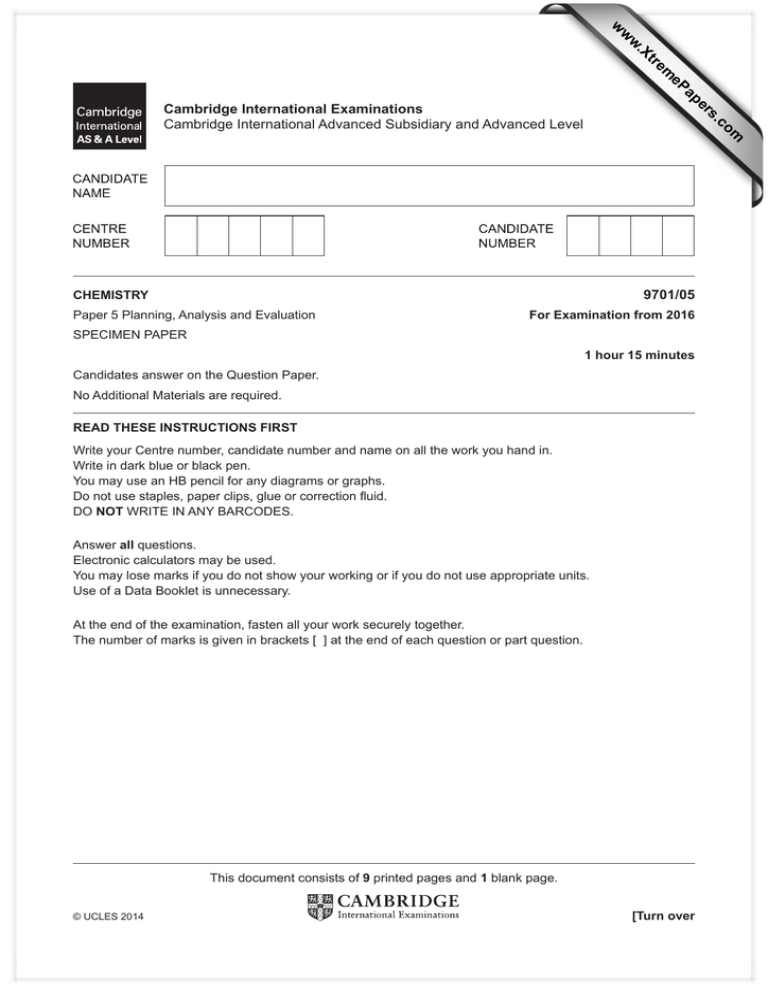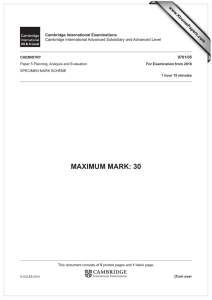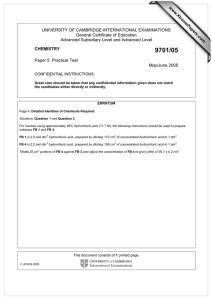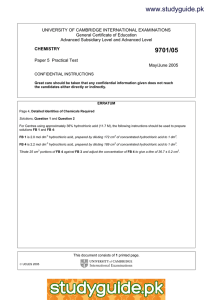www.XtremePapers.com Cambridge International Examinations 9701/05 Cambridge International Advanced Subsidiary and Advanced Level
advertisement

w w ap eP m e tr .X w om .c s er Cambridge International Examinations Cambridge International Advanced Subsidiary and Advanced Level 9701/05 CHEMISTRY Paper 5 Planning, Analysis and Evaluation For Examination from 2016 SPECIMEN PAPER 1 hour 15 minutes Candidates answer on the Question Paper. No Additional Materials are required. READ THESE INSTRUCTIONS FIRST Write your Centre number, candidate number and name on all the work you hand in. Write in dark blue or black pen. You may use an HB pencil for any diagrams or graphs. Do not use staples, paper clips, glue or correction fluid. DO NOT WRITE IN ANY BARCODES. Answer all questions. Electronic calculators may be used. You may lose marks if you do not show your working or if you do not use appropriate units. Use of a Data Booklet is unnecessary. At the end of the examination, fasten all your work securely together. The number of marks is given in brackets [ ] at the end of each question or part question. This document consists of 9 printed pages and 1 blank page. © UCLES 2014 [Turn over 2 1 Hydrochloric acid reacts with solid calcium carbonate in the form of marble chips. The products of the reaction are aqueous calcium chloride, carbon dioxide gas and water. 2HCl(aq) + CaCO3(s) → CaCl2(aq) + CO2(g) + H2O(l) You are to plan an investigation to find out how changes in one variable affect the rate of reaction. (a) (i) The concentration of the hydrochloric acid is one independent variable that could be investigated. Identify two other independent variables that could be investigated. variable 1 ........................................................................................................................... variable 2 ...................................................................................................................... [2] (ii) How would you control each of the two variables that you have identified? variable 1 ........................................................................................................................... ........................................................................................................................................... variable 2 ........................................................................................................................... ...................................................................................................................................... [1] (iii) The volume of carbon dioxide produced is one dependent variable that could be measured to determine the rate of reaction. Identify another dependent variable that you could measure to determine the rate of reaction. ...................................................................................................................................... [1] © UCLES 2014 9701/05/SP/16 3 (b) In order to determine how the rate of reaction between hydrochloric acid and marble chips varies with the concentration of hydrochloric acid, you are provided with some marble chips and 2.00 mol dm–3 hydrochloric acid. In a series of experiments you are to measure the time taken to collect a volume of 100 cm3 of carbon dioxide for several different concentrations of hydrochloric acid. Draw a labelled diagram showing the arrangement of the apparatus that could be used. [3] (c) In each experiment, state the measurements you would need to take to allow you to determine the rate of reaction. ................................................................................................................................................... ................................................................................................................................................... ................................................................................................................................................... ................................................................................................................................................... ................................................................................................................................................... ................................................................................................................................................... .............................................................................................................................................. [2] © UCLES 2014 9701/05/SP/16 [Turn over 4 (d) One of the concentrations that might be used is 0.500 mol dm–3 hydrochloric acid. Describe in detail how you would use a volumetric flask to dilute the 2.00 mol dm–3 hydrochloric acid to obtain 0.500 mol dm–3 hydrochloric acid. ................................................................................................................................................... ................................................................................................................................................... ................................................................................................................................................... ................................................................................................................................................... ................................................................................................................................................... ................................................................................................................................................... .............................................................................................................................................. [3] (e) Explain why the amount in moles of the acid used in the experiments should be considerably greater than the amount in moles of calcium carbonate used. ................................................................................................................................................... ................................................................................................................................................... ................................................................................................................................................... .............................................................................................................................................. [1] (f) Once a range of results has been collected from the experiments, the relationship between the concentration of hydrochloric acid used and the rate of reaction could be determined by plotting a graph. Suggest which variables should be used for the axes of the graph. ................................................................................................................................................... .............................................................................................................................................. [2] [Total: 15] © UCLES 2014 9701/05/SP/16 5 2 A student makes the following prediction. ‘The amount of carbon dioxide evolved when a metal carbonate, X2CO3, reacts with an excess of an acid is directly proportional to the mass of the carbonate used.’ If this statement is true the relative molecular mass of X2CO3 can be determined by the following simple experiment. • • • • • • • • The mass of a weighing bottle containing X2CO3 is measured. 50.0 cm3 of 2.0 mol dm–3 hydrochloric acid (an excess) is transferred from a measuring cylinder to a 250 cm3 conical flask. Sodium carbonate is added to the acid in the flask to saturate the acid with carbon dioxide. This is so that none of the gas given off when X2CO3 reacts with the acid dissolves in the acid. A cotton wool plug is placed in the neck of the flask and the flask + acid is weighed. The weighed X2CO3 is added to the acid in the flask and the cotton wool plug quickly replaced in the neck of the flask to prevent any loss of acid spray. The mass of the empty weighing bottle is measured. When the reaction in the flask has stopped, the flask is left for 10 minutes to allow carbon dioxide to diffuse from the flask. The mass of the flask and its contents after the reaction are measured. © UCLES 2014 9701/05/SP/16 [Turn over 6 The results from a group of students are given in the table below. A B C D mass of weighing bottle + X2CO3 / g mass of empty weighing bottle / g mass of flask + acid before the reaction /g mass of flask + solution after the reaction /g 14.29 11.48 221.35 223.21 16.41 11.76 209.71 212.91 12.24 11.34 210.45 210.97 16.77 11.27 214.38 217.80 16.48 10.68 211.63 215.59 14.85 11.15 217.18 219.68 13.81 11.61 212.12 213.76 18.46 11.06 219.00 224.25 16.18 10.94 206.77 210.31 17.93 11.53 221.49 225.84 14.49 11.09 217.18 219.68 18.19 10.87 215.33 220.31 E F G H (a) Process the results in the table to calculate both the mass of X2CO3 used and the mass of CO2 given off. Record these values in the additional columns of the table. You may use some or all of these columns. Label the columns you use, including the units and an equation to show how the value is calculated. You may use the column headings A to H in these equations, e.g. = C – B. (Remember that the gas is lost from the flask after the weighed carbonate is added to the weighed acid.) [3] © UCLES 2014 9701/05/SP/16 7 (b) Plot a graph to show the relationship between mass of X2CO3 / g and mass of CO2 / g. Draw the line of best fit. 2.4 2.2 2.0 1.8 1.6 mass of CO2 /g 1.4 1.2 1.0 0.8 0.6 0.4 0.2 0 0 © UCLES 2014 1.0 2.0 3.0 4.0 5.0 mass of X2CO3 /g 9701/05/SP/16 6.0 7.0 8.0 [2] [Turn over 8 (c) Circle one clearly anomalous point on your graph. By reference to the description of the experiment, suggest an explanation for this anomaly. ................................................................................................................................................... ................................................................................................................................................... ................................................................................................................................................... ................................................................................................................................................... ................................................................................................................................................... .............................................................................................................................................. [1] (d) Identify any part of the range of readings where the data appears to be less reliable and suggest why this is likely to be the case. ................................................................................................................................................... ................................................................................................................................................... .............................................................................................................................................. [1] (e) (i) Clearly mark two points on your line of best fit suitable to be used to determine the gradient of the line. Write the co-ordinates of the points you have selected below. Use these points to determine the gradient of the line. [2] © UCLES 2014 9701/05/SP/16 9 (ii) Use the gradient you have calculated and the information below to calculate the Mr for X2CO3. X2CO3(s) + 2H+(aq) → 2X+(aq) + CO2(g) + H2O(l) Mr(CO2) = 44.0 Explain your working. The Mr of X2CO3 is .................... [2] (f) Explain how each of the following changes to the experiment would affect the gradient of the graph obtained from the experiment. (i) The experiment is carried out at a higher temperature. ........................................................................................................................................... ...................................................................................................................................... [1] (ii) The experiment is carried out with a different carbonate, Y2CO3, which has a lower Mr than X2CO3. ........................................................................................................................................... ........................................................................................................................................... ........................................................................................................................................... ...................................................................................................................................... [2] (g) Use your knowledge of acid-base chemistry to suggest a more appropriate way by which the Mr of a soluble metal carbonate might be determined. ................................................................................................................................................... ................................................................................................................................................... .............................................................................................................................................. [1] [Total: 15] © UCLES 2014 9701/05/SP/16 10 BLANK PAGE Permission to reproduce items where third-party owned material protected by copyright is included has been sought and cleared where possible. Every reasonable effort has been made by the publisher (UCLES) to trace copyright holders, but if any items requiring clearance have unwittingly been included, the publisher will be pleased to make amends at the earliest possible opportunity. Cambridge International Examinations is part of the Cambridge Assessment Group. Cambridge Assessment is the brand name of University of Cambridge Local Examinations Syndicate (UCLES), which is itself a department of the University of Cambridge. © UCLES 2014 9701/05/SP/16






